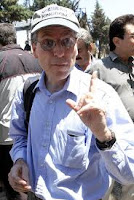Mitt Romney had a painful
public diplomacy teaching moment last week in London. No question about it, Romney stepped off the airplane and put his foot squarely in it.
And, while I wrote this comment at that time, I had decided against posting it -- until
Al Kamen’s column in this morning’s
Washington Post changed my mind and reinforced my conviction. See why below.
What Romney was guilty of, I believe, is a mistake many American
politicians and government officials make every time they travel
abroad.
That is, they forget they are in another country.
They forget that those foreigners are living another, different story from the one we are living at home in the USA.
Too often officials fail to realize that the perception of current
world events in a given foreign country is entirely different from what
we at home have been absorbing from the American mainstream media.
Of course, for most USG visitors, the laser-like focus of the American
and British press is not zeroed in on them, as it was on Romney from the
moment he walked out of Heathrow’s hallways. When most USG officials
and congressmen make a gaffe on foreign soil, they get a pass. Or, more
likely, they don’t get noticed at all. Not so much for presidential
candidates.
But, here’s what I believe happened to Mitt Romney: he departed the USA
toward the end of a busy week on the campaign trail. Doubtless, before
departure, he was reading the usual domestic newspapers (New York
Times, Washington Post) and watching or listening to the usual
broadcasters (ABC, NBC, PBS, etc.). And, the American media were –
especially that week – in a news-free, pre-Olympics feeding frenzy.
Now, any experienced press officer will tell you that when an
international event is in the offing – and especially if there is an
absence of real news – reporters crank out countless, breathless, and
entirely predictable stories about security, inconvenience, how much it
all costs, and colorful accounts of local people criticizing
preparations. There is little enough actual data or facts in these
stories – they usually consist of multiple man-in-the-street interviews
selected to support the reporter’s pre-conceived thesis.
In London this summer, there had been of course plenty of
press criticism of
the Olympic security preparations, the traffic snarls, and the costs.
But, if you actually read the British press closely and compared it to
the American coverage, you saw the difference. The Brits were negative
about the impact of many preparations, griping about the inconvenience,
and shocked at the costs.
But, they were
never in real doubt about whether the Olympics would be successful or something worthy of British pride.
It is a small but important distinction, one that the embassy’s public
diplomacy staff would have felt through their fingertips.
And judging by my experience in the London embassy, the PAO would have
happily briefed the candidate or his staff about the nuances of the
local media environment, the psychology of the local audience, and the
things you could say and should not say. (e.g., “Question the costs,
but don’t question the people’s commitment or the eventual outcome.”)
Public diplomacy advice, grounded in local knowledge, is available to
any prominent American visitor, of any party, at any time. Embassy
officers probably would, if asked, willingly held a “murder board,” a
mock interview, to test questions and responses.
But, I am willing to
bet that neither Romney nor any member of his advance team sought that
kind of specific, on-the ground, finger-on-the-pulse advice from the
Public Affairs Officer or anyone else in the embassy. As
Al Kamen points out, Romney’s traveling staff was small and not particularly attuned.
There are two lessons here, and they apply to any USG official or
prominent person traveling to a foreign country who is likely to be
highly visible and interviewed by local or world media.
Lesson number one is that the way the target country and its current
affairs has been portrayed in the U.S. press is inevitably shaped by the
prism of American culture and politics.
And, it is probably not accurate, at least in the eyes of the other
country. U.S. media often cast foreign stories in the mold of American
perceptions: oversimplification of good guys versus bad guys, tyrants
versus democrats, and waste versus efficiency. It is easy to feed
American exceptionalist mythology by stereotyping foreigners as weak and/or incompetent.
The experienced U.S. visitor abroad assumes that, no matter what he or
she has been reading at home, it is most certainly not what people in
the country have been thinking. In terms of tone and tenor, if not in
terms of crucial facts, what you’ve been absorbing at home does not jibe
with the perspective of most people in the country where you’ve just
arrived.
Lesson number two is that the American visitor absolutely
must
get a thorough briefing on the local situation and host nation
perceptions. You don’t have to go to the American embassy for this, but
you need to get it from someone -- someone who lives there, listens
intelligently, and understands what’s going on.
As
an American ambassador, I was able to insist that
no visiting USG official of any level would have
any
contact with any host country press, officials, or any public audiences
before we at the embassy had a chance to brief the visitor and discuss
the issues.
To do otherwise is to send the visitor walking boldly through a minefield -- without a map.
































